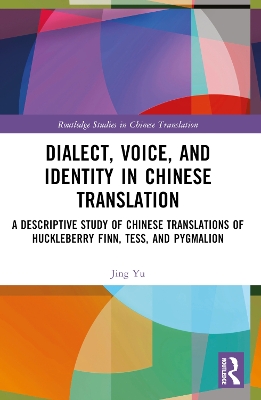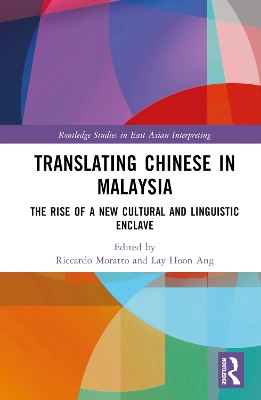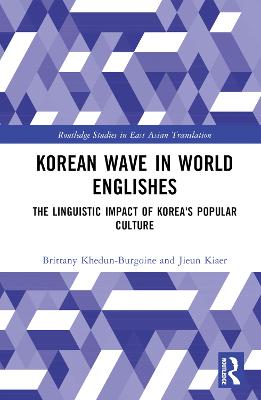Dialect, Voice, and Identity in Chinese Translation
 portes grátis
portes grátis
Dialect, Voice, and Identity in Chinese Translation
A Descriptive Study of Chinese Translations of Huckleberry Finn, Tess, and Pygmalion
Yu, Jing
Taylor & Francis Ltd
11/2024
226
Mole
9781032025995
Pré-lançamento - envio 15 a 20 dias após a sua edição
Descrição não disponível.
Acknowledgments
1. Translating dialect, recreating a voice of difference
1.1 Distinguishing literary dialect from dialect literature
1.2 Voice of difference and the construction of identity for Others
1.3 The (un)translatability of literary dialect
1.4 Approaches and research methods
1.5 Originality and contribution
1.6 Outline of the book
2. Dialect in literature and the various voices in translation
2.1 Dialect in society
2.2 Literary dialect in British and American fiction
2.3 Dialect in Chinese literature
2.4 Literary dialect in translation
3. Standard Chinese and the standardization of dialect
3.1 Dialect in Huck, Tess, and Pygmalion
3.2 Publication of the Chinese translations
3.3 Standardization and the norm of standard Chinese
3.4 Colloquialization and the norm of colloquial speech
4. Creating a different voice: Strategies, tendencies and norms
4.1 Linguistic features and varieties for creating a different voice
4.2 Linguistic varieties for creating a different voice
4.3 Lexicalization and the universal of dialect normalization
4.4 Phoneticization and the translation of African American English
4.5 A diachronic tendency from heterogeneity to homogeneity
5. Register varieties in dialect translation and the reconstruction of Jim's identity in Huck
5.1 Misconception about standard language in dialect translation
5.2 The myth of standard language and the colloquial variety
5.3 Register variety as identity index
5.4 The multiple variations in Twain's Huck
5.5 The vulgar variety and the reconstruction of Jim as Us
5.6 Translating dialects and registers: An integrated approach
6. Dialect frequency and the translation of various dialect voices in Tess
6.1 Dialect frequency and the sub-voices in literary dialect
6.2 A quantitative method for dialect frequency measure
6.3 Translating the various dialectal voices in Tess
6.4 The simplification tendency between early and late translations
6.5 Pioneer translators and follower translators
7. Eliza's two voices and the translation of gender identity in Pygmalion
7.1 Identity reframing in translation
7.2 Multiple themes of Shaw's Pygmalion and Eliza's gendered voice
7.3 Eliza's engendered voice in the 1945 translation
7.4 Eliza's equalitarian voice in the 1956 translation
7.5 The paradox of gender (in)equality and (in)visibility
8. Conclusion
Appendix: List of Chinese translations for Huckleberry Finn, Tess, and Pygmalion from 1931 to 2020
Index
1. Translating dialect, recreating a voice of difference
1.1 Distinguishing literary dialect from dialect literature
1.2 Voice of difference and the construction of identity for Others
1.3 The (un)translatability of literary dialect
1.4 Approaches and research methods
1.5 Originality and contribution
1.6 Outline of the book
2. Dialect in literature and the various voices in translation
2.1 Dialect in society
2.2 Literary dialect in British and American fiction
2.3 Dialect in Chinese literature
2.4 Literary dialect in translation
3. Standard Chinese and the standardization of dialect
3.1 Dialect in Huck, Tess, and Pygmalion
3.2 Publication of the Chinese translations
3.3 Standardization and the norm of standard Chinese
3.4 Colloquialization and the norm of colloquial speech
4. Creating a different voice: Strategies, tendencies and norms
4.1 Linguistic features and varieties for creating a different voice
4.2 Linguistic varieties for creating a different voice
4.3 Lexicalization and the universal of dialect normalization
4.4 Phoneticization and the translation of African American English
4.5 A diachronic tendency from heterogeneity to homogeneity
5. Register varieties in dialect translation and the reconstruction of Jim's identity in Huck
5.1 Misconception about standard language in dialect translation
5.2 The myth of standard language and the colloquial variety
5.3 Register variety as identity index
5.4 The multiple variations in Twain's Huck
5.5 The vulgar variety and the reconstruction of Jim as Us
5.6 Translating dialects and registers: An integrated approach
6. Dialect frequency and the translation of various dialect voices in Tess
6.1 Dialect frequency and the sub-voices in literary dialect
6.2 A quantitative method for dialect frequency measure
6.3 Translating the various dialectal voices in Tess
6.4 The simplification tendency between early and late translations
6.5 Pioneer translators and follower translators
7. Eliza's two voices and the translation of gender identity in Pygmalion
7.1 Identity reframing in translation
7.2 Multiple themes of Shaw's Pygmalion and Eliza's gendered voice
7.3 Eliza's engendered voice in the 1945 translation
7.4 Eliza's equalitarian voice in the 1956 translation
7.5 The paradox of gender (in)equality and (in)visibility
8. Conclusion
Appendix: List of Chinese translations for Huckleberry Finn, Tess, and Pygmalion from 1931 to 2020
Index
Este título pertence ao(s) assunto(s) indicados(s). Para ver outros títulos clique no assunto desejado.
Dialect;Voice;Identity;Region;Dialect Translation;Dorset Dialect;ST Dialect;Vulgar Variety;Phonetic Markers;Literary Dialect;AAVE;African American Vernacular English;Artificial Dialect;Yang Xianyi;Colloquial Variety;In-text Notes;Eye Dialect;Colloquial Features;Dialect Frequency;Dialect Representation;DDM;Authentic Dialect;Dialect Features;Independent Woman;Dialect Markers;Flower Girl;Standard Chinese;Lexical Markers;Standard Language
Acknowledgments
1. Translating dialect, recreating a voice of difference
1.1 Distinguishing literary dialect from dialect literature
1.2 Voice of difference and the construction of identity for Others
1.3 The (un)translatability of literary dialect
1.4 Approaches and research methods
1.5 Originality and contribution
1.6 Outline of the book
2. Dialect in literature and the various voices in translation
2.1 Dialect in society
2.2 Literary dialect in British and American fiction
2.3 Dialect in Chinese literature
2.4 Literary dialect in translation
3. Standard Chinese and the standardization of dialect
3.1 Dialect in Huck, Tess, and Pygmalion
3.2 Publication of the Chinese translations
3.3 Standardization and the norm of standard Chinese
3.4 Colloquialization and the norm of colloquial speech
4. Creating a different voice: Strategies, tendencies and norms
4.1 Linguistic features and varieties for creating a different voice
4.2 Linguistic varieties for creating a different voice
4.3 Lexicalization and the universal of dialect normalization
4.4 Phoneticization and the translation of African American English
4.5 A diachronic tendency from heterogeneity to homogeneity
5. Register varieties in dialect translation and the reconstruction of Jim's identity in Huck
5.1 Misconception about standard language in dialect translation
5.2 The myth of standard language and the colloquial variety
5.3 Register variety as identity index
5.4 The multiple variations in Twain's Huck
5.5 The vulgar variety and the reconstruction of Jim as Us
5.6 Translating dialects and registers: An integrated approach
6. Dialect frequency and the translation of various dialect voices in Tess
6.1 Dialect frequency and the sub-voices in literary dialect
6.2 A quantitative method for dialect frequency measure
6.3 Translating the various dialectal voices in Tess
6.4 The simplification tendency between early and late translations
6.5 Pioneer translators and follower translators
7. Eliza's two voices and the translation of gender identity in Pygmalion
7.1 Identity reframing in translation
7.2 Multiple themes of Shaw's Pygmalion and Eliza's gendered voice
7.3 Eliza's engendered voice in the 1945 translation
7.4 Eliza's equalitarian voice in the 1956 translation
7.5 The paradox of gender (in)equality and (in)visibility
8. Conclusion
Appendix: List of Chinese translations for Huckleberry Finn, Tess, and Pygmalion from 1931 to 2020
Index
1. Translating dialect, recreating a voice of difference
1.1 Distinguishing literary dialect from dialect literature
1.2 Voice of difference and the construction of identity for Others
1.3 The (un)translatability of literary dialect
1.4 Approaches and research methods
1.5 Originality and contribution
1.6 Outline of the book
2. Dialect in literature and the various voices in translation
2.1 Dialect in society
2.2 Literary dialect in British and American fiction
2.3 Dialect in Chinese literature
2.4 Literary dialect in translation
3. Standard Chinese and the standardization of dialect
3.1 Dialect in Huck, Tess, and Pygmalion
3.2 Publication of the Chinese translations
3.3 Standardization and the norm of standard Chinese
3.4 Colloquialization and the norm of colloquial speech
4. Creating a different voice: Strategies, tendencies and norms
4.1 Linguistic features and varieties for creating a different voice
4.2 Linguistic varieties for creating a different voice
4.3 Lexicalization and the universal of dialect normalization
4.4 Phoneticization and the translation of African American English
4.5 A diachronic tendency from heterogeneity to homogeneity
5. Register varieties in dialect translation and the reconstruction of Jim's identity in Huck
5.1 Misconception about standard language in dialect translation
5.2 The myth of standard language and the colloquial variety
5.3 Register variety as identity index
5.4 The multiple variations in Twain's Huck
5.5 The vulgar variety and the reconstruction of Jim as Us
5.6 Translating dialects and registers: An integrated approach
6. Dialect frequency and the translation of various dialect voices in Tess
6.1 Dialect frequency and the sub-voices in literary dialect
6.2 A quantitative method for dialect frequency measure
6.3 Translating the various dialectal voices in Tess
6.4 The simplification tendency between early and late translations
6.5 Pioneer translators and follower translators
7. Eliza's two voices and the translation of gender identity in Pygmalion
7.1 Identity reframing in translation
7.2 Multiple themes of Shaw's Pygmalion and Eliza's gendered voice
7.3 Eliza's engendered voice in the 1945 translation
7.4 Eliza's equalitarian voice in the 1956 translation
7.5 The paradox of gender (in)equality and (in)visibility
8. Conclusion
Appendix: List of Chinese translations for Huckleberry Finn, Tess, and Pygmalion from 1931 to 2020
Index
Este título pertence ao(s) assunto(s) indicados(s). Para ver outros títulos clique no assunto desejado.
Dialect;Voice;Identity;Region;Dialect Translation;Dorset Dialect;ST Dialect;Vulgar Variety;Phonetic Markers;Literary Dialect;AAVE;African American Vernacular English;Artificial Dialect;Yang Xianyi;Colloquial Variety;In-text Notes;Eye Dialect;Colloquial Features;Dialect Frequency;Dialect Representation;DDM;Authentic Dialect;Dialect Features;Independent Woman;Dialect Markers;Flower Girl;Standard Chinese;Lexical Markers;Standard Language







